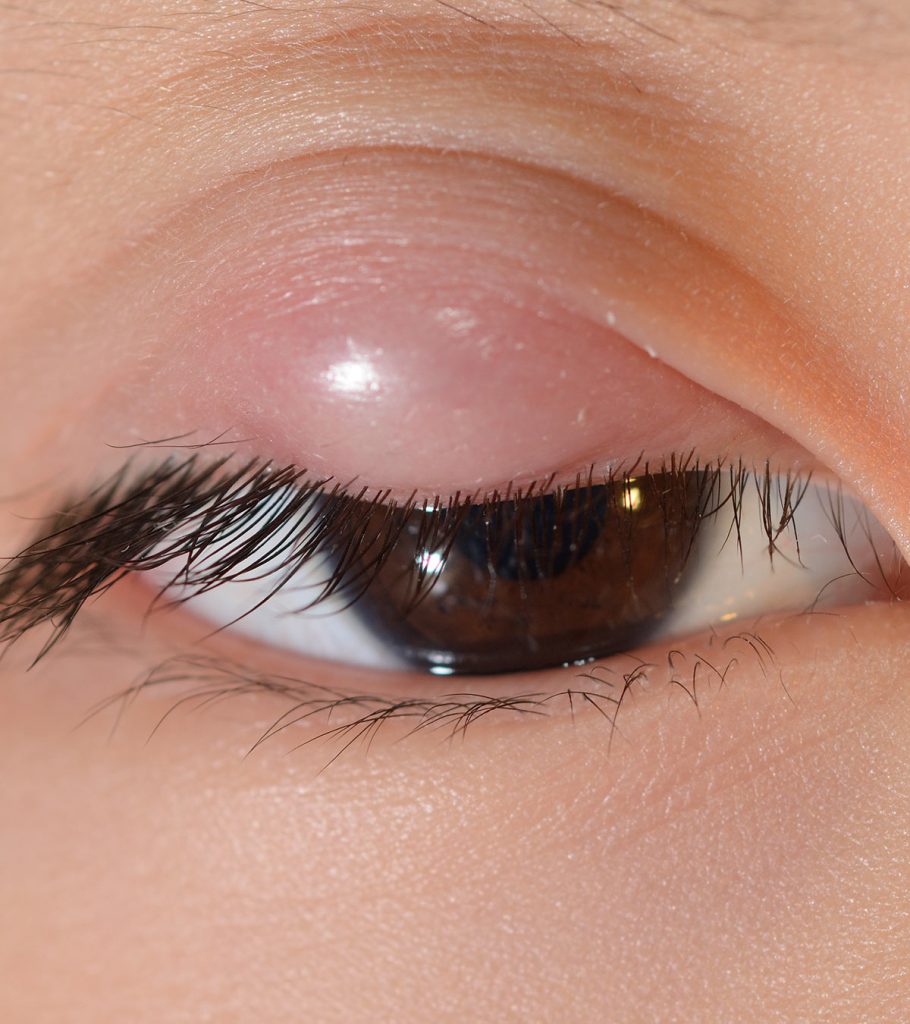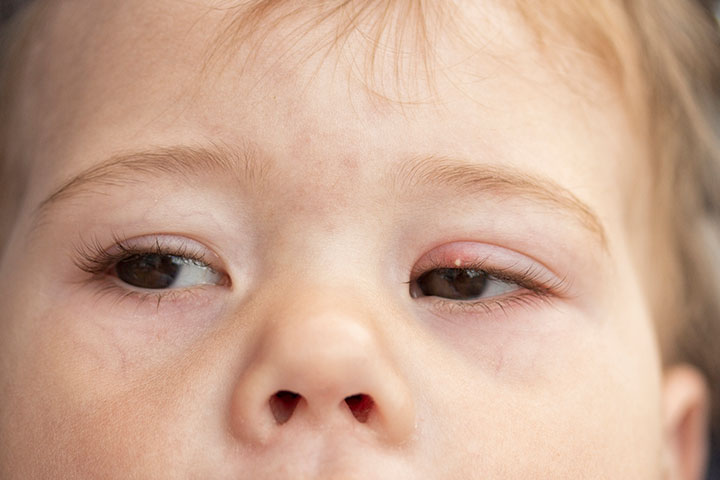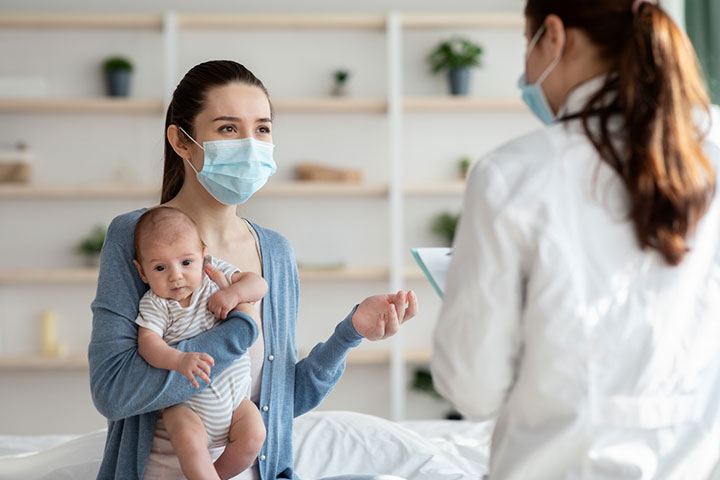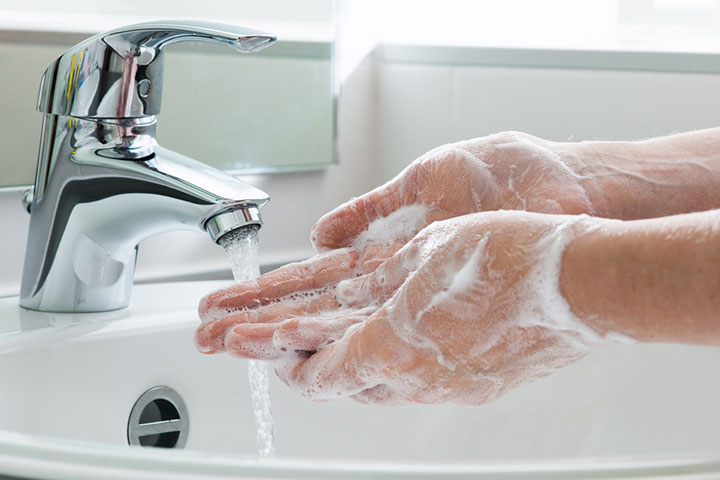Sty in babies appears as a swelling on the eyelid. It happens due to various reasons, such as blocked sweat glands or hair follicle infection. The condition may temporarily affect the vision of the baby. However, it is self-limiting and does not usually need any medical treatment. Nevertheless, it is important to consult a doctor if you find any worrying symptoms in the baby, such as fever, fussiness, or rashes. This post tells you about the causes of sty in babies, its symptoms, treatments, and ways of prevention.
What Is A Sty?
A sty, also spelled stye and medically known as a hordeolum, is a painful boil-like structure seen at the base of the eyelash(1). It appears along the margin of the affected eye, resulting in swollen eyelids. A sty can be painful and may make babies irritable and fussy.
A sty or a hordeolum is broadly classified into two categories:
- Internal hordeolum: Infection that occurs in the meibomian glands (oil glands) inside the eyelid.
- External hordeolum: A localized infection in the hair follicle of an eyelash.
A sty may be confused with chalazion, which is an obstructed gland in the eyelid. A chalazion swelling is similar to sty swelling but the former is not painful. A chalazion could be a chronic problem.
Are Styes Common In Babies?
A sty is common but its incidence rate in babies is not known because most cases are not documented. Babies with certain diseases or conditions like diabetes or seborrhoeic dermatitisiXA skin condition marked by scaly rashes in oily areas of the body, such as the face and scalp. might be more prone to styes (1). According to the data from Cleveland Clinic, infantile seborrhoeic dermatitis (also known as cradle crap) is prevalent among seven out of ten babies aged between two and six weeks.
What Are The Symptoms Of Styes In Babies?
Look for any changes in the color, size, and shape of your baby’s eyelid. Styes can be painful, so a baby may be fussy, irritable, and repeatedly rub the affected eyelid. An eyelid affected with sty can display the following symptoms.
- Eye swelling
- Bump-like growth
- Eye crustiness along the eyelid
- Red eyes and itchiness
- Eye pain and soreness accompanied by eye itching
- Discharge of yellowish mucus
- Sensitivity to light
- Eye inflammation, particularly the eyelid area
- Watery eyes or tearing due to eye discomfort
What Are The Causes Of Styes In Babies?
Below are some of the likely causes of sty in babies.
- The blocked ducts of sebaceous glands within the eyelid cause the accumulation of oil and fluids. This fluid is invaded by bacteria such as Staphylococcus aureusiXA pathogenic bacteria that may cause infections in the interior eye regions, such as eyelids and tear duct., thus causing a bacterial infection, which gets presented as a sty (1). Sometimes, a viral infection could also cause a sty.
- Sweat glands present at the rim of the eyelid may get blocked and the blocked sweat glands get infected by bacteria and cause sty.
- An infection within the hair follicle of an eyelash may also lead to the formation of sty.
Babies who had sty before have a greater risk of getting a sty again (2).
How Is Sty Diagnosed In Babies?
The diagnosis of sty usually requires only a physical exam of the eyelid and assessing the medical history of the baby. No diagnostic tests are required for a sty (1). Your doctor may suggest further tests when some other problem is suspected.
Physical exam can help know if it is a sty or a chalazion(3). Also, the size of the sty may indicate the extent of the infection (4).
How To Treat Styes In Babies?
Mostly, styes resolve on their own in two weeks with spontaneous drainage of the abscess (5). Medical intervention is most often not needed.
An eye treatment, if required, is likely to be a combination of home remedies and medication. The following treatment methods could help provide relief to the baby (4).
- Warm water compresses: Dip a clean cloth in lukewarm water, squeeze it to remove water, and gently place it on the affected eyelid. Warm compresses may be applied for about five minutes, four to five times a day. It may help in removing the blockage in the duct of the gland, and help the sty heal faster (6). Be careful to use only lukewarm water, and only place the cloth on the eye for five minutes or less.
- Erythromycin topical ointment: Use of topical antibiotic ointment in the inferior fornix if the lesion is draining or if there is an accompanying blepharoconjunctivitis. The topical ointment does not cure the sty itself, but helps in the prevention of the spread of eye infection (1). No antibiotics should be used without a doctor’s prescription.
- Lid scrubs: Lid scrubs typically contain a saline solution. They promote eyelid hygiene by clearing off the debris from the lid margin, which in turn helps in the resolution of sty. They should only be used on a doctor’s recommendation(4).
- Oral antibiotics: In a few cases, if an untreated chronic sty develops into cellulitis, then your baby’s doctor might prescribe oral antibiotics (1).
- Incision and drainage: In very rare cases, where topical and systemic antibiotics don’t work, incision and drainage might be done to remove the infected tissue with pus from the sty (4).
The treatment for both internal and external hordeolum is the same. Never massage or touch a sty since it may accidentally pop and cause the fluids to drain into the eye. It is always good to seek a doctor’s advice even before trying home remedies for eye care.
When To See A Doctor?
Visit a doctor if you don’t see any improvement in the baby’s sty after two weeks.
You should seek medical intervention sooner if a sty is accompanied with symptoms such as (7):
- Fever
- Loss of appetite
- Rashes on other areas of the body
- Recurring or multiple styes
- Excessive eye irritation and fussiness
- Baby seems to have trouble seeing and you suspect a problem with their vision
How To Prevent Styes In Babies?
Maintaining optimum eye hygiene is important in preventing styes. The following habits may help:
- Wash your hands before touching the baby and their personal items to prevent the spread of bacteria from you to them.
- Use a mild baby-safe soap to wash the baby’s face.
- Keep the baby’s towels and clothes separate.
- Prevent eye rubbing or squeezing eyelid
Sty in babies could be due to an infection of the hair follicle or blocked sweat glands. Although it is not a serious issue, the bulge in the eye could make your child uncomfortable. Usually, a sty subsides on its own by applying a warm compress. Maintaining good hygiene helps ensure sty doesn’t recur. However, if the bulge concerns you, you could always consult your physician to get their opinion. Alternatively, if the stye causes eye redness or is accompanied by other symptoms such as fever, consult your doctor.
Key Pointers
- Painful swelling on the eyelids called a stye can make babies fussy and uncomfortable.
- Symptoms include red and itchy eyes, swelling, irritation, and yellow mucus discharge from the eyes.
- Sty is caused by a blocked sweat gland or sebaceous gland, and an infection within the hair follicle of the eyelash.
- Treatment options for stye in babies include oral antibiotics, warm compresses, and topical creams.
- Seek medical attention if the stye is accompanied by symptoms such as fever, rashes, recurring or multiple styes, vision impairment, or increased irritability.















